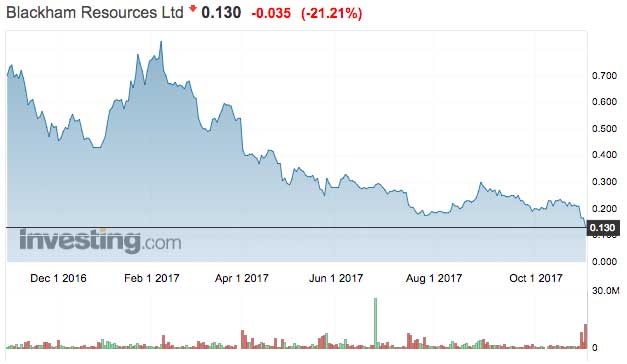Blackham production costs show the risks in buying gold hype
Mining
Mining
As the Pilbara gold rush keeps running, Blackham Resources may be a cautionary tale for investors buying into pre-production promises.
Blackham’s shares (ASX:BLK) have dived 40 per cent since its quarterly results came out on Friday. The shares closed at 13c on Tuesday after about 10 per cent of the stock had changed hands.
Blackham sold its gold at an average price of $1617 an ounce in the last three quarters.
But according to Stockhead calculations, once all expenses are taken into account, average costs for the first three quarters was about $2200/oz.
Blackham has lost between $400/oz and $700/oz in each quarter this year, based on selling gold at $1600/oz.
Furthermore, before it’s even embarked on a major expansion, its debt levels are looking high.
Blackham’s managing director Bryan Dixon declined to comment, but the company said in a statement on November 1 that it expects to be cash flow positive this quarter on the back of higher grades of ore.

A golden dream
Blackham is a West Australian gold producer.
It bought the Wiluna gold prospect from Apex Minerals in 2011. Wiluna — which has changed hands several times in the past 30 years — has never been especially productive, but had a gold potential of some 300,000 oz.
Apex’s lofty targets of 200,000 oz a year were never met — it produced only 385 oz.
But the potential was hard to ignore and Blackham began production in the last quarter of 2016, after lifting the resource number from 300,000 oz to a healthy 6.5 million oz.
Harder to extract than expected
Blackham raised a whopping $80.25 million at prices as high as $1 a share between March last year and February this year, on the back of Wiluna’s gold potential.
But it’s yet to hit forecast production. In fiscal 2017 it forecast production of 60,000 to 70,000 oz of gold but heavy rains and low grades meant it achieved 39,413 oz.
Production this year has been around 15,000 oz a quarter at grades of up to 1.4 grams per tonne (g/t).
Blackham is still touting the Apex figure, saying it can hit 207,000 oz/year for six years after a planned expansion is finished in June 2019.
It says it’s going to fund that out of its dwindling cash flow.
Staying solvent
Blackham does not appear to have the cash to keep its current operations running for long.
The company says its “C1” cash cost of production has been between $1100/oz and $1400/oz this year — an extremely high number for a gold miner. C1 is the cost of production compared to the volumes of gold produced.
Once all expenses have been taken into account, Stockhead found that the average cost for the first three quarters of the calendar year was about $2200/oz.
Blackham has lost between $400/oz and $700/oz in each quarter this year, based on the prices it’s selling gold at of around $1600/oz.
As well as losing money on gold production, it also has to contend with debt.
It has $7.2 million in the bank but is carrying $36.7 million in debt.
To solve this problem, Blackham signed an equity deal with New York fund, Lind Partners, for $72 million.
The promise is that Lind will provide $3 million a month. The catch is that they get stock at a discount — a diluting option for the shareholders who’ve invested $80 million already.
Blackham also said in a statement the day after this article that it is refinancing that debt.
It said it has a “credit approved term sheet” to refinance the $36.7 million, meaning the $14.8 million which originally had to be paid by the end of December is now due in June 2020.